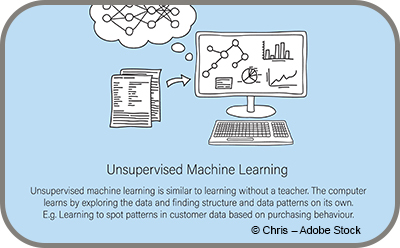Unsupervised Learning in the Real World
To understand how unsupervised learning works, consider a massive sample of images of different animals. With supervised learning, this data pool would be categorized into the different animals like dogs, cats, fishes, birds, monkeys, etc. However, with unsupervised learning, those labels would not be there. The expectation is that the system would classify the images into different categories.
So, in this case, instead of categorizing by species, you would instead find the algorithm looking for distinguishing characteristics. As such, you might see pictures of dogs and cats and even monkeys lumped together in a category called “fur.” Birds would be grouped into a “feather” category, and so on.
By looking for patterns in data, unsupervised learning algorithms can quickly make distinctions. As the algorithm continues analyzing the data, it clusters the data in different ways. The most common clusters are as follows:
- k-Means clustering
- Exclusive clustering
- Hierarchical clustering
- Probabilistic clustering
Raw AI training datasets for teaching artificial intelligence (AI) algorithms can be efficiently obtained via clickworker.
Unsupervised Learning in the World of AI
Unsupervised learning as a way of teaching and educating AI algorithms has its pros and cons. From the point of view of cost and resource allocation, it is definitely more effective than supervised learning. However, one problem with unsupervised learning is that it is difficult to know whether it is actually getting the job done.
With supervised learning, the algorithm has specific inputs and expected outputs. It is easy to understand how accurate the AI model is, and the algorithm can be tweaked to improve accuracy further. This same capability does not exist within unsupervised learning. If a sample data set does suit natural clustering, it could be an excellent fit, however.
Unsupervised learning algorithms are capable of processing more complex data vs. supervised learning systems. While they might add new and unexpected categories to the data, they are often considered to generative learning models. As such, their capabilities will improve from one generation to the next.




